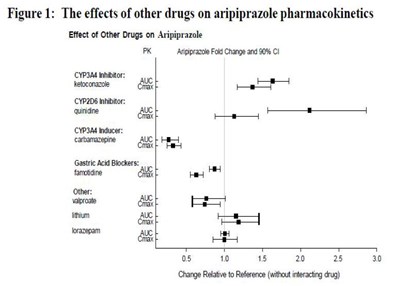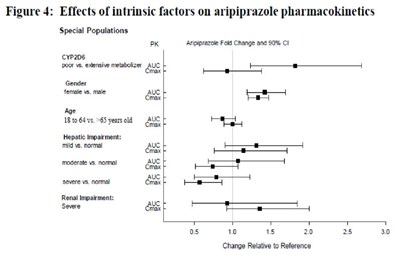Product Images Aripiprazole
View Photos of Packaging, Labels & Appearance
- image containerlabel 15
- image fig1 effectofotherdrug arip
- image fig2 effectofotherdrug dehydroarip
- image fig3 effectofarip otherdrug
- image fig4 effectofintrinsicfactor arip
- image fig5 effectofintrinsicfactor dehydroarip
- image fig6 schizophreniastudy 5
- image fig7 bipolarstudy 7
- image fig8 bipolarstudy 8
- image fig9 tourettesdisorderstudy1
- image logo medguide
- image logo pi
- image structure
Product Label Images
The following 13 images provide visual information about the product associated with Aripiprazole NDC 68788-7006 by Preferred Pharmaceuticals Inc., such as packaging, labeling, and the appearance of the drug itself. This resource could be helpful for medical professionals, pharmacists, and patients seeking to verify medication information and ensure they have the correct product.
image containerlabel 15

This appears to be a description of Aripiprazole tablets which are a generic version of the brand Abilify. Each tablet contains 15mg of aripiprazole. However, there is a caution mentioned at the beginning which warns about Feerl law prohibiting tarsteror Aol T USP Lmg. It is unclear what this warning pertains to.*
image fig1 effectofotherdrug arip

This text provides a figure showing the effects of different drugs on the pharmacokinetics of aripiprazole. The drugs include CYP3A4 inhibitor ketoconazole, CYP2D6 inhibitor quinidine, CYP3M4 inducer carbamazepine, gastric acid blockers famidine, and other drugs such as valproate, lithium, and lorazepam. The figure shows the fold change and 90% confidence interval of aripiprazole relative to the reference (without interacting drug) after administration of each drug.*
image fig3 effectofarip otherdrug

This text shows figure 3 that represents the effects of aripiprazole on the pharmacokinetics of other drugs, displaying the fold change and 50% confidence interval of different drugs such as deropmetoptan, cvpace, artann, Roartain, omeprazole, UoTiAd, lamotigine, alproate, lithium, lorazepam, venidaine, Odesmyhenataing, and escitiopram, measured in comparison to the reference without interacting drug, and plotted over a range from 0 to 30.*
image fig4 effectofintrinsicfactor arip

The text describes the effects of intrinsic factors like special populations, age, gender, hepatic impairment, and renal impairment on the pharmacokinetics of aripiprazole. The data is presented in Figure 4 as fold change and 90% confidence intervals for AUC and Cmax. The figures demonstrate the effects of poor vs. extensive metabolizers, gender, age, and severity of hepatic and renal impairment using different colors. However, there is no readable text given for specific values, so no exact conclusions can be made.*
image fig5 effectofintrinsicfactor dehydroarip

The figure 5 shows the impact of intrinsic factors on the pharmacokinetics of dehydro-aripiprazole. It presents fold changes and confidence intervals at different levels of severity for renal impairment, hepatic impairment, age, gender, and CYP2D6 metabolizer status. The data is presented as changes relative to the reference group.*
image fig6 schizophreniastudy 5

This is a graph showing the Kaplan-Meier estimation of the cumulative proportion of patients with relapse in Schizophrenia Study 5. The graph compares the use of aripiprazole versus placebo. There is also a table showing the number of subjects at risk for both treatments. The x-axis of the graph shows the days from randomization.*
image fig7 bipolarstudy 7

This is a graph (Figure 7) showing the Kaplan-Meier estimation of the cumulative proportion of patients with relapse in a Bipolar Study 7. The graph compares the drug Aripiprazole to a placebo. The number of subjects at risk is displayed on the right side. The X-axis represents the days from randomization.*
image fig8 bipolarstudy 8

The figure shows the Kaplan-Meier estimation of the cumulative proportion of patients experiencing relapse to any mood event in Bipolar Study 8. The proportion of patients with relapse is plotted against the number of days from randomization. The medication studied was ABILIFY, and there were 168 patients included in the analysis. The text "LACE 169 7 7" is not clear and may be a transcription error.*
image fig9 tourettesdisorderstudy1

The text describes a figure numbered 9 that shows the least square means of change in YGTSS TTS by week for a study on Tourette's Disorder. It also reports a change in YGTSS total tic score from baseline and provides a table with the least square means of change in YGTSS for each week of treatment.*
* The product label images have been analyzed using a combination of traditional computing and machine learning techniques. It should be noted that the descriptions provided may not be entirely accurate as they are experimental in nature. Use the information in this page at your own discretion and risk.



